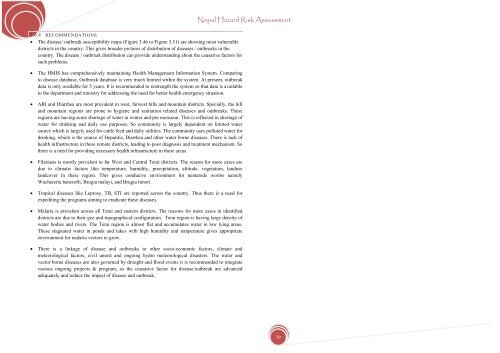Nepal Hazard Risk Assessment - Asia-Pacific Gateway for Disaster ...
Nepal Hazard Risk Assessment - Asia-Pacific Gateway for Disaster ...
Nepal Hazard Risk Assessment - Asia-Pacific Gateway for Disaster ...
Create successful ePaper yourself
Turn your PDF publications into a flip-book with our unique Google optimized e-Paper software.
<strong>Nepal</strong> <strong>Hazard</strong> <strong>Risk</strong> <strong>Assessment</strong><br />
3.6.8 RECOMMENDATIONS<br />
• The disease/ outbreak susceptibility maps (Figure 3.46 to Figure 3.51) are showing most vulnerable<br />
districts in the country. This gives broader pictures of distribution of diseases / outbreaks in the<br />
country. The disease / outbreak distribution can provide understanding about the causative factors <strong>for</strong><br />
such problems.<br />
• The HMIS has comprehensively maintaining Health Management In<strong>for</strong>mation System. Comparing<br />
to disease database, Outbreak database is very much limited within the system. At present, outbreak<br />
data is only available <strong>for</strong> 5 years. It is recommended to restrength the system so that data is available<br />
to the department and ministry <strong>for</strong> addressing the need <strong>for</strong> better health emergency situation.<br />
• ARI and Diarrhea are most prevalent in west, farwest hills and mountain districts. Specially, the hill<br />
and mountain regions are prone to hygiene and sanitation related diseases and outbreaks. These<br />
regions are having acute shortage of water in winter and pre monsoon. This is reflected in shortage of<br />
water <strong>for</strong> drinking and daily use purposes. So community is largely dependent on limited water<br />
source which is largely used <strong>for</strong> cattle feed and daily utilities. The community uses polluted water <strong>for</strong><br />
drinking, which is the source of Hepatitis, Diarrhea and other water borne diseases. There is lack of<br />
health infrastructure in these remote districts, leading to poor diagnosis and treatment mechanism. So<br />
there is a need <strong>for</strong> providing necessary health infrastructure in these areas.<br />
• Filariasis is mostly prevalent in far West and Central Terai districts. The reason <strong>for</strong> more cases are<br />
due to climatic factors like temperature, humidity, precipitation, altitude, vegetation, landuse<br />
landcover in these region. This gives conducive environment <strong>for</strong> nematode worms namely<br />
Wuchereria bancrofti, Brugia malayi, and Brugia timori.<br />
• Tropical diseases like Leprosy, TB, STI are reported across the country. Thus there is a need <strong>for</strong><br />
expediting the programs aiming to eradicate these diseases.<br />
• Malaria is prevalent across all Terai and eastern districts. The reasons <strong>for</strong> more cases in identified<br />
districts are due to their geo and topographical configuration. Terai region is having large density of<br />
water bodies and rivers. The Terai region is almost flat and accumulates water in low lying areas.<br />
These stagnated water in ponds and lakes with high humidity and temperature gives appropriate<br />
environment <strong>for</strong> malaria vectors to grow.<br />
• There is a linkage of disease and outbreaks to other socio-economic factors, climate and<br />
meteorological factors, civil unrest and ongoing hydro meteorological disasters. The water and<br />
vector borne diseases are also governed by drought and flood events it is recommended to integrate<br />
various ongoing projects & program, so the causative factor <strong>for</strong> disease/outbreak are advanced<br />
adequately and reduce the impact of disease and outbreak.<br />
79
















